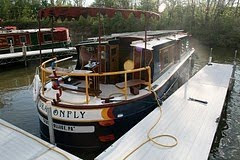 |
| Pretty nice dock for a winery! |
Soon after we started work at Everglades Park last winter, we
noticed that questions from visitors were predictable. “Where’s the bathroom?” “Where
do we get boat tickets?” And, “We just have half a day here, where can we see alligators?”
(Or, insert the charismatic megafauna of your choice: Manatees? Wood storks? Flamingos?
Sea turtles?)
Again and again, park visitors gave us the message that they’d
like to be able to see these species by appointment. Go to the appointed place
at the appointed time, and voila, an alligator! Or a manatee.
But wild animals don’t pop out on demand. Their populations
are small, their home ranges are large, and their habits are . . . well,
sometimes regular. But not always.
Also, many species tend to be most active at dusk or dawn .
. . times that are outside of normal park visiting hours.
We had some memorable wildlife sightings while we were stationed
in the Everglades: a couple manatees on the Blackwater River lolling just arms-length
from our kayaks; wood storks by the dozens, clustered in the marsh at sunset at
the 10,000 Islands National Wildlife Refuge; a loggerhead sea turtle rearing his head, the
size of a fishing float, ahead of us in the channel by Sandfly Island.
But that was because we spent lots (and lots) of time outside.
If we’d calculated “exciting-sightings-per-hour,” the yield would have been pitiable.
Low Expectations
When we started this trip, we had low expectations for
wildlife sightings. We knew we’d feel perfectly happy to see the predictable local
denizens: bald eagles in Montezuma Marsh, ospreys on their nesting platforms,
great blue herons around almost every bend.
Early Bird Gets the Worm . . . or Something
We shut up the boat Monday night after a relaxing
afternoon at the solar-powered Thirsty Owl Winery. We were feeling pleased at the
sunset show we’d just enjoyed. But we had no particular expectations that the winery
docks would hold any adventure or excitement for us.
At seven the next morning, I rolled over to the sound of Bill
opening the rear double doors. But he didn’t charge up the steps as he usually
does. Instead, I heard an urgent whisper.
“Berge, come here! And bring your binoculars!”
I scampered out of bed to join him at the door.
And there, glowing in the morning sun, was a mama merganser with
a whole flotilla of babies, eight in all, steaming along purposefully.
One alternative name for the common merganser is the “sheldrake.”
The spit of land that juts into the lake, right where we were docked, is Sheldrake Point. I’d never really appreciated that name before!
The spit of land that juts into the lake, right where we were docked, is Sheldrake Point. I’d never really appreciated that name before!
Don't Put Away the Bins Just Yet
 As we admired the spunky baby ducks, paddling at speed to
keep up with Mom, a mink scampered onto the dock in front of us.
As we admired the spunky baby ducks, paddling at speed to
keep up with Mom, a mink scampered onto the dock in front of us.He snatched up a chunk of fish (perhaps dropped by a gull or osprey) and started gnawing on it like a hungry dog.
Usually, when you see a mink, it’s just a flash of brown at
the edge of the channel. Almost as soon as you realize what you’re seeing, it’s
gone.
But this mink was taking his ease, chewing and swallowing,
gnawing and chewing.
When he was done, he patrolled the length of the dock and back,
nose to the boards, looking for other tidbits. Then he slipped fluidly down to
the end of the dock, along the shore, and into the undergrowth.
The Conservation Report
Although many North American bird species are seeing precipitous declines, Common Merganser populations are stable or increasing. Later that morning, we spotted a sizable flock of females loafing together on a snag.
Minks are also considered a “species of least concern” in New York State.
Water pollution is the greatest threat to both species.
 |
| What a great way to start the day! |






No comments:
Post a Comment